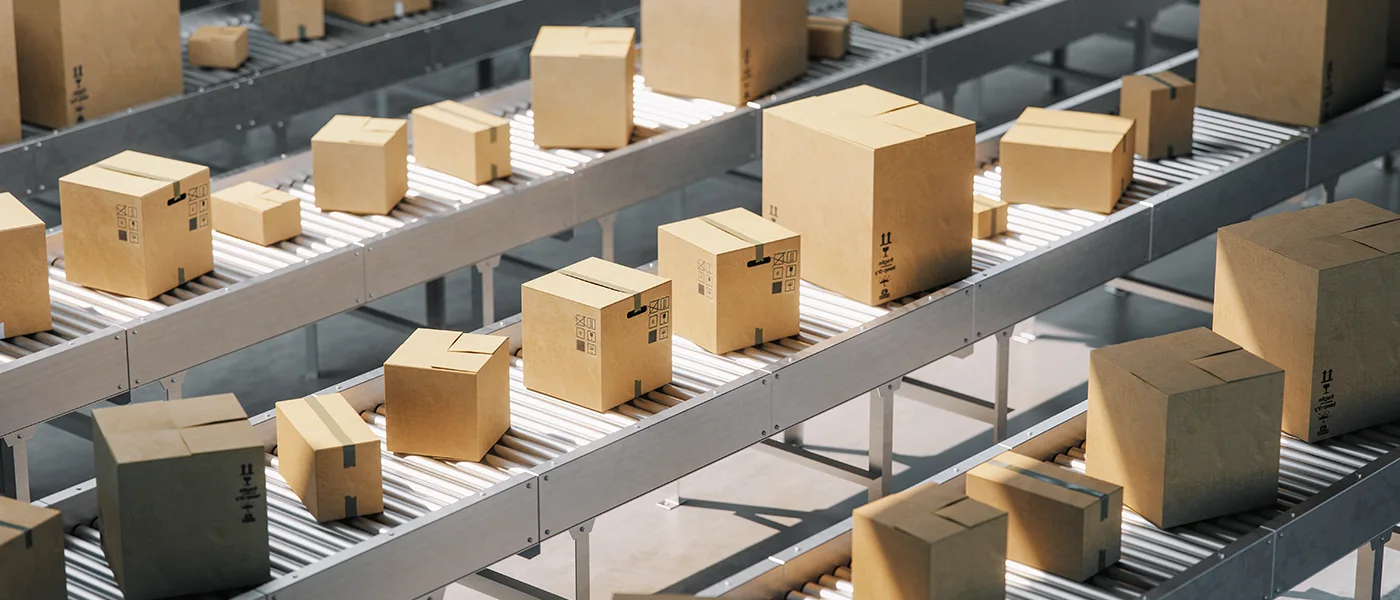Welcome to the comprehensive guide on logistics strategy, designed to help you streamline your e-commerce operations. In this guide, we’ll provide practical advice and proven strategies to streamline your supply chain and drive success in the competitive e-commerce landscape.
With many years of experience in logistics and fulfillment, Locad is here to empower you with actionable insights and best practices.
Discover how to align your logistics goals with business objectives, optimise inventory management, enhance warehouse operations, and make informed decisions for efficient transportation and technology.
Get ready to unlock the full potential of your e-commerce operations with an effective logistics strategy. Let’s dive in!

What is a Logistics Strategy?
A logistics strategy is a comprehensive plan that outlines how e-commerce businesses manage the flow of goods and services from suppliers to customers. It involves strategically coordinating various activities, such as procurement, inventory management, warehousing, transportation, and order fulfillment. A logistics strategy aims to optimise these processes to meet e-commerce customer demands efficiently while minimising costs and maximising overall performance. By developing a well-defined logistics strategy, businesses can gain a competitive edge by improving operational efficiency, reducing delivery times, and enhancing customer satisfaction.

What is the Difference Between Logistics Strategy and Logistics Operation?
While the terms “logistics strategy” and “logistic operation” are often used interchangeably, they refer to distinct aspects of e-commerce operations. Understanding these two concepts’ differences is crucial for developing a comprehensive logistics approach. Let’s explore the disparities:
Logistics Strategy
A logistics strategy is a high-level plan that outlines the overarching approach and goals for managing the flow of goods and services within an e-commerce business. It involves strategic decision-making and long-term planning to optimise the entire supply chain. The logistics strategy considers factors such as customer demands, market trends, competitive landscape, and business objectives. It determines the best practices and principles to achieve operational excellence and gain a competitive advantage.
Logistic Operation
Logistic operations, on the other hand, focus on the day-to-day execution of the logistics strategy. It involves the tactical implementation of various activities within the supply chain, including procurement, inventory management, warehousing, transportation, and order fulfillment. Logistic operations ensure the smooth flow of goods and services from suppliers to customers, adhering to the guidelines and principles set forth in the logistics strategy. It encompasses tasks such as coordinating shipments, managing inventory levels, tracking orders, and handling returns.
The logistics strategy provides the overarching framework and direction for logistics operations. It sets the vision, goals, and guiding principles, while logistic operations involve practically implementing those strategies to ensure the efficient movement of goods and services.
To put it simply, the logistics strategy is the “what” and “why,” determining the overall approach, while logistic operations are the “how,” focusing on the execution and management of day-to-day logistics tasks.
Understanding this distinction is crucial as it helps businesses develop a holistic logistics approach combining a well-defined strategy and effective operational execution. By aligning both aspects, e-commerce businesses can achieve seamless supply chain management and drive success in a competitive e-commerce marketplace.
E-commerce Logistics Automation: Definition, Objectives, Challenges, Best Practices & Actionable Insights [+Templates]
Welcome to our comprehensive guide on logistics automation for e-commerce businesses. In today’s fast-paced digital landscape, efficient and streamlined logistics…
The Importance of a Logistics Strategy

A well-defined logistics strategy is crucial for e-commerce businesses to thrive in today’s competitive market. This section will highlight the key reasons why having a strong logistics strategy is essential for streamlining operations and achieving business success.
Enhanced Operational Efficiency
A logistics strategy enables businesses to streamline operations by establishing efficient processes and workflows. By optimising the flow of goods, minimising bottlenecks, and eliminating unnecessary steps, businesses can improve productivity, reduce costs, and achieve higher operational efficiency.
Cost Optimization
Effective e-commerce logistics management can significantly impact cost savings. With a well-planned strategy, businesses can identify cost-effective transportation routes, minimise inventory holding costs, optimise warehouse space utilisation, and leverage technology to automate processes. This cost optimisation directly translates into higher profit margins and a competitive edge in the market.
Improved Customer Satisfaction
A well-executed logistics strategy ensures timely and accurate order fulfillment, faster delivery times, and reliable customer service. By meeting customer expectations consistently, businesses can build trust, increase customer loyalty, and gain a competitive advantage. Satisfied customers are more likely to recommend the business to others, leading to organic growth and a positive brand reputation.
Scalability and Flexibility
As e-commerce businesses grow, scalability becomes critical. A logistics strategy provides a framework for managing growth and adapting to changing market demands. By designing scalable logistics processes, businesses can handle increased order volumes, expand into new markets, and respond quickly to fluctuations in demand.
Competitive Advantage
In the highly competitive e-commerce landscape, a well-executed logistics strategy can be a key differentiator. By optimising supply chain processes, businesses can offer faster delivery, flexible shipping options, and superior inventory management compared to their competitors. This competitive advantage can attract more customers, increase market share, and drive business growth.
Key Components of a Logistics Strategy

A successful logistics strategy comprises several key components that work together to optimise e-commerce operations. Understanding these components is essential for developing an effective logistics strategy that aligns with your business objectives. Here are the key components to consider:
Demand Forecasting
Accurate demand forecasting is the foundation of an effective logistics strategy. By analysing historical data, market trends, and customer insights, businesses can anticipate future demand and plan their inventory levels accordingly. This enables them to minimise stockouts, reduce excess inventory, and ensure timely order fulfillment.
Supplier Management
Managing suppliers is a critical aspect of logistics strategy. It involves building strong relationships, negotiating favourable terms, and ensuring a reliable supply of goods. By collaborating closely with suppliers, businesses can improve lead times, reduce costs, and maintain consistent product quality.
Inventory Management
Efficient inventory management is vital to avoid overstocking or understocking. A well-designed logistics strategy incorporates inventory optimisation techniques such as just-in-time (JIT) inventory, ABC analysis, and safety stock calculations. This helps businesses minimise holding costs, improve cash flow, and meet customer demand without delays.
Warehouse Optimisation
Optimising warehouse operations is key to efficient logistics. This involves organising storage areas, implementing efficient picking and packing processes, and leveraging technology like warehouse management systems (WMS) and logistics automation. An optimised warehouse layout and streamlined workflows enable businesses to minimise order processing times, reduce errors, and improve overall operational efficiency.
Transportation Strategy
Developing an effective transportation strategy is crucial for timely and cost-effective order delivery. It involves selecting the right transportation modes (e.g., road, air, sea), optimising routes, and collaborating with logistics service providers. Businesses must consider factors such as delivery speed, cost, reliability, and environmental impact when designing their transportation strategy.
Technology Integration
Integrating technology into logistics processes can significantly enhance efficiency. Businesses can leverage inventory management software, order management systems (OMS), transportation management systems (TMS), and data analytics tools to automate processes, gain real-time visibility, and make data-driven decisions. Technology integration improves accuracy, reduces manual errors, and enables businesses to scale their operations effectively.
Performance Measurement
Monitoring and measuring key performance indicators (KPIs) is essential to evaluate the effectiveness of a logistics strategy. Logistics KPIs such as order fulfillment rate, on-time delivery, inventory turnover, and transportation costs provide valuable insights into operational performance. By regularly analysing these metrics, businesses can identify areas for improvement, make data-driven adjustments, and optimise their logistics strategy over time.
By focusing on these key components, businesses can develop a robust logistics strategy that maximises operational efficiency, minimises costs, and ultimately drives success in the competitive e-commerce landscape.
Logistics Strategy Principles
Developing a successful logistics strategy is built upon a foundation of key principles that guide decision-making and ensure effective execution. By adhering to these logistics strategy principles, e-commerce businesses can streamline operations and achieve optimal outcomes. Here are the fundamental principles to consider:
Customer-Centric Approach
Place the customer at the heart of your logistics strategy. Understand their preferences, demands, and expectations to design logistics processes that deliver exceptional customer experiences. Prioritise factors such as fast and accurate order fulfillment, transparent tracking, and hassle-free e-commerce returns to build customer loyalty and satisfaction.
Supply Chain Visibility
Establish end-to-end visibility across your supply chain. Implement technology solutions that provide real-time insights into inventory levels, order status, and transportation tracking. Enhanced visibility enables proactive decision-making, timely issue resolution, and efficient coordination with suppliers and logistics partners.
Cost Efficiency
Strive for cost-efficient logistics operations without compromising quality or customer satisfaction. Identify opportunities to reduce costs through optimised inventory management, efficient transportation routes, effective packaging, and lean warehouse processes. Continuously analyse cost drivers and explore innovative solutions to achieve cost savings.
Risk Management
Mitigate risks associated with logistics operations by implementing robust risk management strategies. Identify potential disruptions, such as natural disasters, supplier issues, or transportation delays, and develop contingency plans to minimise their impact. Proactively monitor and manage risks to ensure uninterrupted operations and timely delivery.
Collaboration and Partnerships
Foster collaboration and build strong partnerships with suppliers, logistics service providers, and technology vendors. Establish mutually beneficial relationships based on trust, transparency, and shared goals. Collaborative partnerships enable seamless coordination, access to specialised expertise, and enhanced capabilities for handling complex logistics challenges.
Sustainability
Incorporate sustainable practices into your logistics strategy. Strive to minimise the environmental impact of your operations by optimising transportation routes, reducing packaging waste, adopting eco-friendly technologies, and exploring alternative energy sources. Aligning with sustainable principles benefits the planet, enhances your brand reputation, and attracts environmentally conscious customers.
By embracing these logistics strategy principles, e-commerce businesses can develop a solid foundation for their logistics operations. These principles serve as guiding principles to ensure that logistics strategies are customer-centric, cost-efficient, adaptable, and sustainable.
Best Practices for Developing a Logistics Strategy
Developing an effective logistics strategy requires careful planning and consideration of various factors. By implementing the following best practices, e-commerce businesses can create a robust logistics strategy that aligns with their overall objectives and drives success:
- Align Logistics Goals with Business Objectives: Ensure your logistics strategy aligns with your broader business goals. Understand your target market, customer expectations, and competitive landscape to develop logistics objectives that support your business’s growth and profitability.
- Conduct Regular Data Analysis: Utilize data analytics tools to gain insights into your supply chain performance. Analyse key metrics such as order fulfillment rates, transportation costs, inventory turnover, and customer satisfaction to identify areas for improvement and make data-driven decisions.
- Foster Collaboration: Collaborate closely with suppliers, e-commerce logistics service providers, and other stakeholders to build strong relationships and foster a spirit of collaboration. Effective communication and collaboration can lead to better coordination, improved service levels, and cost savings throughout the supply chain.
- Invest in Technology: Leverage technology solutions to automate and optimise logistics processes. Implement inventory management systems, order management systems, transportation management systems, and other relevant tools to enhance visibility, streamline operations, and improve efficiency.
- Continuously Improve Processes: Embrace a culture of continuous improvement within your logistics operations. Regularly evaluate and optimise processes, identify bottlenecks, and implement innovative solutions to enhance efficiency and stay ahead of the competition.
- Prioritise Customer Experience: Strongly emphasise delivering exceptional customer experiences through your logistics strategy. Focus on fast and reliable order fulfillment, accurate tracking, responsive customer service, and flexible delivery options to exceed customer expectations and build loyalty.
- Stay Agile and Flexible: The e-commerce landscape is constantly evolving, so it’s crucial to remain agile and adaptable. Design your logistics strategy with scalability and flexibility, allowing your operations to adjust to changing market demands, new technologies, and emerging trends.
- Invest in Training and Development: Provide your logistics team with ongoing training and development opportunities. Equip them with the necessary skills and knowledge to handle complex logistics challenges, embrace new technologies, and stay up-to-date with industry best practices.
- Monitor Industry Trends: Stay informed about the latest trends and innovations in logistics and e-commerce. Keep an eye on emerging technologies, regulatory changes, and customer expectations to proactively adjust your logistics strategy and maintain a competitive edge.
- Regularly Review and Update: A logistics strategy is not a one-time exercise but an ongoing process. Regularly review and update your logistics strategy to align with your evolving business goals, market dynamics, and customer demands.
By implementing these best practices, e-commerce businesses can develop a robust and adaptable logistics strategy that drives operational excellence, enhances customer satisfaction, and fosters business growth.
Successful Southeast Asian E-commerce Brands with Effective Logistics Strategies
In Southeast Asia, several e-commerce brands have demonstrated their prowess in implementing effective logistics strategies to enhance customer satisfaction and achieve operational efficiency. Let’s explore three prominent e-commerce logistics case studies: Havaianas, Lazada, and Shopee.
Havaianas: Boosting Customer Satisfaction with Locad’s Fulfillment Solutions
Havaianas, a leading flip-flop brand under Terry SA, partnered with Locad to optimise its fulfillment operations. By leveraging Locad’s cutting-edge solutions, Havaianas achieved faster order dispatch, reduced delivery periods, and improved inventory management.
Key takeaways from Havaianas’ success include the importance of outsourcing fulfillment, automation of processes, and the value of real-time data analytics in driving decision-making.
Stepping Up the E-Commerce Game: How Havaianas Delivered 4x Faster Shipping Through Locad
Learn how leading flip flop brand Havaianas, under lifestyle retail giant Terry SA, leveraged LOCAD’s cutting-edge fulfillment solutions to provide…
Lazada: Enhancing Last-Mile Delivery through Technology and Partnerships
Lazada, one of Southeast Asia’s largest e-commerce platforms, has implemented an array of logistics strategies to enhance last-mile delivery. They have leveraged technology, including artificial intelligence and data analytics, to optimise their delivery network. Additionally, Lazada has established strategic partnerships with local logistics providers, enabling them to tap into their extensive reach and knowledge of local markets.
The key takeaways from Lazada’s logistics strategy include leveraging technology for delivery optimisation, partnering with local logistics providers, and prioritising customer-centric solutions.
Locad+Lazada
Locad+Lazada Maximize Lazada sales with hassle-free operations Install now Locad offers a convenient and cost-effective solution for Lazada marketplace sellers to ship orders…
Shopee: Streamlining Operations with an Integrated Logistics Ecosystem
Shopee, a popular e-commerce platform in Southeast Asia, has built an integrated logistics ecosystem to streamline operations and provide a seamless customer experience. They have established partnerships with logistics providers to offer a wide range of delivery options and enable efficient order fulfillment. Shopee has also invested in warehousing infrastructure and technology solutions to ensure inventory management and timely deliveries.
Key takeaways from Shopee’s logistics strategy include building an integrated ecosystem of logistics partners, investing in warehousing infrastructure and technology, and offering diverse delivery options to cater to customer preferences.
Locad + Shopee
Locad + Shopee Scale with seamless selling from Shopee Install now Locad connects seamlessly with Shopee sellers to manage inventory. When you get…
Key Takeaways For A Strong Logistics Strategy:
- Collaboration and partnerships: Successful e-commerce brands in Southeast Asia emphasise collaboration with logistics partners, service providers, and technology vendors to optimise their operations and achieve scale.
- Data-driven decision-making: Effective logistics strategies rely on real-time data analytics to gain insights into key metrics, improve inventory management, and enhance overall performance.
- Automation and technology adoption: Investing in automation, AI-driven systems, and advanced technology solutions allows for faster order processing, improved last-mile delivery, and enhanced customer satisfaction.
- Customer-centric approach: Prioritizing customer satisfaction and convenience by offering faster delivery times, diverse delivery options, and efficient order fulfillment is crucial for success in the competitive e-commerce landscape.
These brands serve as inspirations for other Southeast Asian e-commerce players to develop and implement effective logistics strategies that drive growth, operational excellence, and customer loyalty.
Unlock Your E-commerce Potential with Locad’s Fulfillment Solutions
To achieve success in the ever-evolving e-commerce landscape, businesses must leverage advanced fulfillment solutions that streamline operations, optimise efficiency, and enhance customer satisfaction. Locad, a leading fulfillment partner, offers a range of services designed to meet the unique logistics needs of Southeast Asian e-commerce brands. Let’s explore how Locad can help businesses unlock their e-commerce potential.
Fast and Reliable Order Fulfillment
Locad’s cutting-edge fulfillment solutions enable businesses to dispatch orders quickly and efficiently. With their expertise in warehouse management, order picking, and packing, Locad ensures that your customers receive their orders on time. You can optimise the entire fulfillment process by leveraging Locad’s advanced technology and automation systems, reducing order processing time and minimising errors.
Scalable and Flexible Operations
As your e-commerce business grows, it is essential to have a fulfillment partner that can scale operations seamlessly. Locad’s flexible infrastructure and extensive network of warehouses allow businesses to expand their reach and handle increasing order volumes. Whether you’re looking to enter new markets or cater to peak seasons, Locad can adapt to your needs and provide the necessary resources to support your growth.
Advanced Inventory Management
Locad’s state-of-the-art inventory management system provides real-time visibility into your stock levels, ensuring accurate inventory tracking and minimising the risk of overselling or stockouts. By automating and syncing inventory updates with all your e-commerce platforms, Locad helps you maintain optimal stock levels, reduce fulfillment errors, and enhance customer satisfaction.
Data-Driven Insights
Locad’s Control Tower provides businesses with comprehensive data analytics and reporting capabilities. With a full view of the fulfillment journey, you can gain valuable insights into key metrics such as order processing time, delivery performance, and customer satisfaction. This data-driven approach empowers you to make informed decisions, identify areas for improvement, and optimise your logistics operations for greater efficiency and profitability.
Focus on Core Competencies
By partnering with Locad for fulfillment services, e-commerce businesses can offload operational complexities and logistics management tasks. This lets you focus on your core competencies, such as product development, marketing, and customer engagement. Locad’s expertise in fulfillment ensures that your orders are handled precisely, leaving you free to concentrate on growing your business and delivering exceptional customer experiences.
In the dynamic and competitive landscape of Southeast Asian e-commerce, partnering with Locad can be a game-changer for your business. Their advanced fulfillment solutions, combined with their industry knowledge and expertise, can help you navigate logistics challenges and unlock your e-commerce potential. Embrace the power of Locad and take your e-commerce operations to new heights.
A Quick Summary Of Logistics Strategy
- Logistics strategy focuses on efficiently managing the flow of goods and information within a supply chain.
- Key elements include transportation, inventory management, warehousing, order processing, and technology integration.
- Effective logistics strategy enhances customer satisfaction, reduces costs, improves inventory management, and increases operational efficiency.
- Transportation planning, optimal inventory levels, streamlined order processing, efficient warehouse operations, and leveraging technology for real-time visibility are important factors to consider.
- Collaboration with reliable partners and continuous performance evaluation is crucial for success.
- Data analytics and automation can provide valuable insights and optimise logistics operations.
- Emphasise packaging optimisation, accurate dimensioning, and scalability for future growth.
- Implementing innovative solutions and continuous improvement is essential to stay competitive in the evolving logistics landscape.
Experience fulfillment by Locad today!
FAQ’s
What are the four main types of transportation in logistics?
Transportation is an integral part of the logistics of a business. There are mainly four types of freight transport through which a company transports goods and products throughout its supply chain. They are air, rail, maritime, and road shipments. Which means they ship items via planes, trains, ships and trucks.
How are logistics and transportation different?
Even though they are closely connected and often confused, transportation and logistics are different. Transportation only deals with moving the products and goods from one physical place to another in a supply chain. Logistics deals with the flow of goods, services, information and products within the supply chain. It helps improve connectivity within the different links of the system.
What factors should you consider while planning a logistics strategy?
While planning your logistics strategy, some factors or components are transportation, competitors, outsourcing, and customer satisfaction.
What is a logistics strategy?
A logistics strategy is a planning and management technique that improves the flow of information, products, services and goods within a supply chain by improving the connectivity of the different sectors within the supply chain.
Why are logistics partners important?
When managing a business, it is best to delegate different aspects to experienced people. That is why, a logistics partner will be able to handle your logistical needs better than if you did it all by yourself. It will also allow you to focus on other core aspects of your business.
![E-commerce Logistics Automation: Definition, Objectives, Challenges, Best Practices & Actionable Insights [+Templates] 1 future of smart warehousing](https://golocad.com/wp-content/uploads/2022/06/DRONE-1.png)







